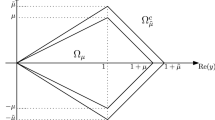Abstract:
This is the second of two papers on the zero-viscosity limit for the incompressible Navier-Stokes equations in a half-space in either 2D or 3D. Under the assumption of analytic initial data, we construct solutions of Navier-Stokes for a short time which is independent of the viscosity. The Navier-Stokes solution is constructed through a composite asymptotic expansion involving the solutions of the Euler and Prandtl equations, which were constructed in the first paper, plus an error term. This shows that the Navier-Stokes solution goes to an Euler solution outside a boundary layer and to a solution of the Prandtl equations within the boundary layer. The error term is written as a sum of first order Euler and Prandtl corrections plus a further error term. The equation for the error term is weakly nonlinear; its linear part is the time dependent Stokes equation. This error equation is solved by inversion of the Stokes equation, through expressing the solution as a regular (Euler-like) part plus a boundary layer (Prandtl-like) part. The main technical tool in this analysis is the Abstract Cauchy-Kowalewski Theorem.
Similar content being viewed by others
Author information
Authors and Affiliations
Additional information
Received: 5 September 1996 / Accepted: 14 July 1997
Rights and permissions
About this article
Cite this article
Sammartino, M., Caflisch, R. Zero Viscosity Limit for Analytic Solutions of the Navier-Stokes Equation on a Half-Space.¶ II. Construction of the Navier-Stokes Solution . Comm Math Phys 192, 463–491 (1998). https://doi.org/10.1007/s002200050305
Issue Date:
DOI: https://doi.org/10.1007/s002200050305



